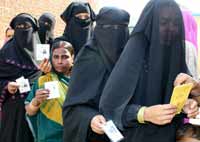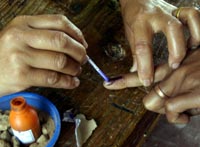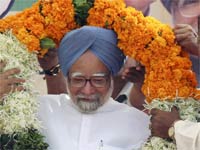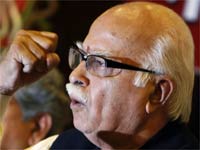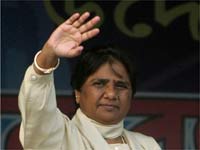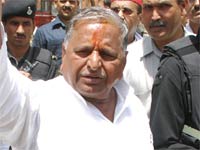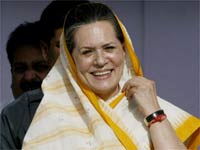India election - the parties
More than 40 parties chase 543 seats
by Rosslyn Hyams
Article published on the 2009-04-24 Latest update 2009-05-01 13:33 TU
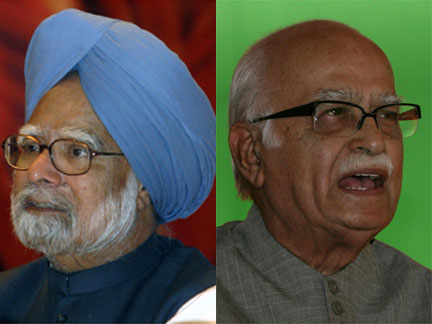
India's Congress Party Prime Minister Manmohan Singh (L), Hindu-nationalist Bharatiya Janata Party (BJP) leader and prime ministerial candidate LK Advani (R)
photo: REUTERS/Punit Paranjpe+REUTERS/Amit Dave
There are some 40 regional parties which have a more or less strong footing in India’s states. Any one regional party may defend as many as 36 seats in the outgoing Lok Sabha, or none at all, even if it has a strong position in state assemblies.
By comparison, the leading party of the current coalition, the Congress, is by itself defending 145.All parties run their campaigns and are recognised on polling chits by a distinctive logo ranging from a simple star to a detailed bungalow or an alarm clock and a spinning top.
This assists those who cannot read to identify the party of their choice as they cast their electronic votes in the polling booth. To ensure voters only cast one ballot, their fingers are marked with ink.
The National Parties:
The Indian National Congress (INC), originated as an independence movement when India was under British rule. Founded in 1885, it became a major political party after independence and its leader JL Nehru was elected as the first Prime Minister in 1952.In 1967, the Congress, split into two parties. The faction that was led by Nehru’s daughter, Indira Gandhi, was recognised as the INC. She was assassinated in 1984 and her son Rajiv took over.
He was assassinated in 1991, during the election campaign which the Congress was hoping would take it back to power after being defeated in the 1989 general election. Narasimha Rao took the reins of the party.
Today it is Rajiv's widow, Sonia Gandhi, who is party president. She turned down offers to become Prime Minister, for fear of criticism of her Italian origins. Since 2004, Manmohan Singh has been Congress Prime Minister.
In 1999, Congress's performance hit an all-time low. But it rebounded in 2004 to lead the United Progressive Alliance which includes 12 other parties and can expect support from another four parties which are not part of the UPA.
The future leader of the Congress Party could be Rahul Gandhi, son of Rajiv and Sonia, grandson of Indira, and great-grandson of Jawaharlal Nehru. Rahul Gandhi’s photo is one of the three on the home page of the Congress Party’s website along with his mother and the current prime minister.
In its manifesto 2009, the party pledges to work for security, respect and prosperity of all citizens, and states that it will introduce measures to ensure that economic growth is maintained and protect farmers from the impact of a global slowdown. It also says it will guarantee health security for all, zero tolerance towards terrorism and combat communalism.
The Bharatiya Janata Party (BJP), which means the Indian people’s party, was born out of the Bharatiya Jan Sangh (BJS), which became part of the Janata Dal coalition which won the 1977 general election, after the end of the Congress-imposed state of emergency.The BJP split from the Janata Party in 1980 after the government collapsed the year before. Its first leader was Atal Bihari Vajpayee who led the Indian government as Prime Minister in 1996 for 13 days, and in 1998.
Fresh elections were called in 1999, with the BJP again coming out in front and staying in power for a full five-year term. The BJP-led Alliance came a close second to the Congress in 2004, with 138 seats to Congress’s 145.
In its election manifesto for 2009, the BJP says it's putting the poor first, addressing the difficulties faced by farmers, the urban poor, women and the elderly. It also says it will take steps to crack down on corruption.
The BJP’s candidate for the premiership in 2009, LK Advani was one of the leading political figures to incite the destruction of the Babri mosque at Ayodhya in Uttar Pradesh in 1992, which led to an eruption of communal violence between Hindus and Muslims. Advani later tried to diminish his responsibility for the ensuing communal slaughter that left at least 900 people dead. In an autobiography, he wrote that he had not envisaged such consequences.The Communist Party of India-Marxist (CPIM), CPIM came about after a rift in the Communist Party of India (CPI) in 1964. The CPIM leads the Left Front Alliance. It won 43 seats in the last election. It is the third largest political party in India. One of the seven national parties, the Left Front Alliance governs the states of West Bengal, Tripura and Kerala.
In its manifesto the CPIM underscores the need for secularism and national unity, land reforms, reinforced democracy, a self-reliant economy, social justice and independent foreign policy.
The Communist Party of India (CPI) won ten seats in the 2004 elections, more than double the number it had won in the polls in 1999. It is one of the older parties in India, founded under British rule, in 1925. The CPI has joined with other left-wing parties in the Left Front Alliance.
Like the CPIM, the CPI had also been part of the Congress-led federal government since 2005. They and other left-wing parties pulled out when the government signed a civilian nuclear deal with the United States in late 2008. They considered the agreement would compromise India's sovereignty as well as its independence in world affairs.
The party's manifesto calls for secular polity and independent economic development to ensure economic and social justice for all.
The Bahujan Samaj Party (BSP), the Majority People's Party, says its stand for the "social transformation and economic emacipation" of the dalits (so-called scheduled castes) and other social or religious minority groups. It was founded in 1984 as a state party and its president, Mayawati Kumari, is currently Chief Minister of Uttar Pradesh (UP), one of India's most densely populated states .Following a pact after the 2002 UP State elections with the BJP, the BSP won an absolute majority in 2007. It was the first time since 1991 that one party had garnered enough votes to be able to govern the state alone. The BSP's main rival in UP is the Samajwadi. Given the BSP's growth over recent years, it could be one of the key pieces in the make-up of the expected coalition that will govern India after the 2009 general elections. It would be a member of the Third Front alliance of some communist and smaller parties
The other national parties are the Nationalist Congress Party and the Rashtriya Janata Dal.
Some key State parties:
Samajwadi Party (SP), the Socialist Party, has its base in Uttar Pradesh among certain castes and Muslims. The SP is led by Mulayam Singh Yadav a former national Defence Minister.The SP was founded in 1992 and describes itself as a democratic socialist party. It is one of the parties which sprung from the former Janata Dal (People's Party) when it broke up into a number of regional parties. In the last elections, the SP won 36 seats, 35 of them in UP and one in Uttaranchal State, which used to be part of UP. It is the fourth largest party in the house. It helped the Congress-led coalition pass the US nuclear deal-related legislation.
The SP manifesto for the 2009 elections focuses on a bid to improve the lot of farmers, with special reference to the state of Maharashtra, of which Mumbai is capital. Another main point in the SP manifesto is about improving relations with India's neighbours, Pakistan and Bangladesh, as a way to eradicate terrorism.
Dravida Munnetra Kazhagam (DMK), is the ruling party of the state of Tamil Nadu. It came out of the Dravidia Kazzhagam party which split in 1972 after its foundation in 1949, shortly after independence from Britain. It enjoys strong support in neighbouring Pondicherry, and is defending 16 seats in the outgoing Lok Sabha.
The DMK is led by Tamil Nadu's Chief Minister, Kalaignar M Karunanidhi. It joined with the Congress-led UPA and took part in the government.
All India Anna Dravida Munnetra Kazhagam (AIDMK), is one of the two big Tamil parties in India, based in the State of Tamil Nadu in the south-east of the country. The party was founded in 1972, a break-away faction from the DMK. Its founder was a film star of the times, MG Ramachandran. In 1977, AIDMK ousted the DMK from state government and remained in power until 1987.
The current leader Jayalalitha Jayaram took charge of the AIDMK in 1991 and a year later the party regained their control of Tamil Nadu. Since then, the seat of power in the state has alternated between AIDMK and DMK.
In the last general election in 2004, AIDMK fared badly, losing all 33 Lok Sabha seats it had contested.
New Party Lines
Professionals Party of India (PPI), is new, young and representing the up-and-coming middle-class voter bracket. It's early days, as the PPI is fielding for example, only two candidates in Mumbai. One of them is an eye-surgeon, the other is in business, and at the same is a social activist. Their manifesto says it's time for India's estimated 200 million professionals to roll up their sleeves and dirty their hands. The party aims to be transparent and accountable.
Like other younger candidates, some of whom are standing as independents, the PPI is calling for more efficient political leadership, an end to corruption and no more lawmakers with criminal records. They want policies that bring Indians together and do not divide among caste, religious or regional lines.
Alliances
United Progressive Alliance (UPA), is led by the incumbent centre-left coalition-ruling party, Congress and chaired by Sonia Gandhi, the party's president. There are seven other parties this year, including the Trinamool Congress, a party based in West Bengal. Others are the Sikkim Democratic Front, Jharkhand Mukti Morcha, the DMK (see above), the Maharasthra-based Republican Party of India (Athvale), the national Nationalist Congress Party as well as the Indian Union Muslim League and the All India Majis-e-ittehadul Muslimeen.The National Democracy Alliance (NDA) is led by the BJP. It was established to form a coalition government after the 1998 election. Apart from the BJP, there are eight parties in the NDA, including Maharashtra state’s far-right, Shiv Sena. Former Indian Prime Minister Atal Bihari Vajpayee is the chairman of the alliance. Each of the seven regional parties hails from a different region, from Nagaland, through UP and Haryana to Karnata and Punjab.
The Third Front (TF) is a new pre-electoral alliance of parties in India. Its main goal is to provide an alternative to the Congress and BJP. It was launched formally in March 2009. It has a broader voter appeal than the Left Front, and the two Communist Parties of India have joined up. The TF was initiated by Deve Gowda, leader of the Janata Dal Secular (JDS), and former Prime Minister of India. His idea was to ally the secular and non-Congress parties. The ten TF parties also include the Tamil Nadu-based (AIDMK) and two Telugu parties (TDP and TRS) based in the central southern Andra Pradesh.
The Left Front, is made up of nine socialist and communist parties, national or regional. The two biggest ones are the Communist Party of India Marxist (CPI) and Communist Party of India (CPI). The left parties have said that they will not support a Congress-led government.




